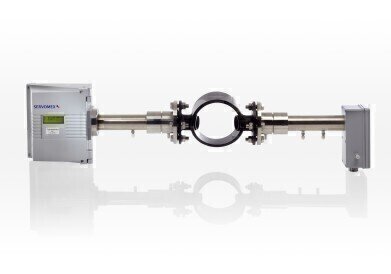Measurement and Testing
Innovative TDLS Combustion Analysis System
Sep 30 2012
Servomex (UK), specialist manufacturer of gas analysis solutions, has installed an innovative solution for combustion analysis on ethylene cracker furnaces installed at Shell Netherlands Chemie B.V.
Coinciding with a furnace refurbishment programme, the new flue gas analysis solution enables optimisation of the combustion control process leading to improved fuel efficiency and reduced carbon monoxide (CO).
SERVOTOUGH LaserSP 2900 cross-stack analysers were installed across the 13-meter radiant sections of the ethylene cracker furnace to monitor both Oxygen (O2) and Carbon Monoxide (CO) within the flue gas. The LaserSP employs the Tuneable Diode Laser Spectroscopy (TDLS) technique to make a path averaged measurement of the process gas concentrations close to the burners, enabling rapid process optimisation.
To protect the analyser optics it is common practise to flow purge gas over the windows of TDLS in-situ analysers, which are exposed to the hot process gas stream. In flue gas measurements, it has been necessary to employ dry N2 as the window purge gas, as opposed to instrument air, because ambient O2 is sufficiently high to interfere with the O2 process measurement. However, in partnership with Shell Moerdijk, the infra-red scan range of the LaserSP was extended to include additional absorption lines which only appear at elevated temperatures, greater than 600°C. By using one of these “hot lines” to monitor the process O2, it is possible to use instrument air as the window purge gas, as the O2 in the instrument air, being colder than the 600°C, is no longer “seen” at the process monitoring “hot” wavelength. The standard “cold” O2 absorption line was also monitored and this signal is utilised for the purposes of checking the LaserSP’s response to a test gas, and to provide an alarm in the event of an interruption of the flow of window purge gas.
Over a long process path measurement (in this case 13 meters), thermally induced flexing of the furnace walls to which the analyser is mounted can result in the laser “spot” at the receiver end of the analyser to move. With the usual parallel laser beam this would have led to a measurement failure when the laser spot moved out of the field of view of the receiver unit. This was overcome by adjusting the laser transmitter optics to diverge the beam such that the laser “spot” diameter was three times the diameter of the optical receiver lens. In this way the transmission of the laser beam to the receiver remains unaffected by thermal movements of the process. This “receiver overfilling” technique is only made possible as a result of the LaserSP’s second harmonic (2f) wavelength modulated signal (WMS) processing, which operates at a 200kHz carrier signal frequency, almost eliminating signal noise.
With two LaserSP analysers installed in-situ on each ethylene furnace for the measurement of 0-10% O2 and 0-1000ppm CO respectively, the combined solution is helping Shell Netherlands Chemie B.V. optimise process efficiency by reducing fuel consumption and process emissions, as well as reducing installation and operational costs.
Digital Edition
PIN 25.2 Apr/May
April 2024
In this Edition Safety - Carbon monoxide toxic and flammable gas detection Analytical Instrumentation - Density: A fundamental parameter at critical stages within the petroleum sector...
View all digital editions
Events
May 08 2024 Lahore, Pakistan
May 13 2024 New Orleans, LA, USA
May 14 2024 Tashkent, Uzbekistan
May 14 2024 Oklahoma City, OK, USA
May 15 2024 Lund, Sweden


















